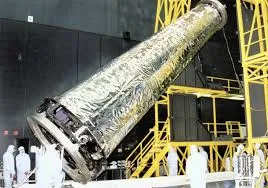Chandrayaan-2:
Chandrayaan-2 is India's second lunar exploration mission, developed and launched by the Indian Space Research Organisation (ISRO). It is a follow-up mission to Chandrayaan-1, India's first lunar mission, which was launched in 2008.
Here are the key details about Chandrayaan-2:
1. Launch Date:
Chandrayaan-2 was launched on July 22, 2019, aboard a GSLV Mk III-M1 rocket from the Satish Dhawan Space Centre in Sriharikota, India.
 |
| Chandrayaan-2 |
2. Objectives:
The primary objectives of Chandrayaan-2 were to study the lunar surface, analyze the distribution of elements and minerals, map the moon's topography, and study the exosphere of the moon.
3. Components:
Chandrayaan-2 consisted of three main components:
Orbiter: The orbiter, which continues to orbit the moon, is equipped with various scientific instruments to study the lunar surface and atmosphere.
Vikram Lander: The lander was designed to make a soft landing on the moon's south polar region and deploy the Pragyan rover.
Pragyan Rover: The rover, named Pragyan, was designed to move on the lunar surface, conduct experiments, and send data back to Earth.
4. Lunar Landing Attempt:
The Vikram lander, carrying the Pragyan rover, attempted a soft landing near the moon's south pole on September 6, 2019. However, during the descent, communication with the lander was lost, and it crash-landed on the lunar surface. Despite the setback, the orbiter continued its mission successfully.
5. Scientific Discoveries:
The Chandrayaan-2 orbiter has made significant scientific discoveries, including the detection of water ice on the moon's surface and mapping of various elements and minerals. It has provided valuable data for lunar research.
6. Future Missions:
Despite the setback with the lander, ISRO announced plans for Chandrayaan-3, a follow-up mission aiming for another attempt at landing on the moon's surface, utilizing lessons learned from Chandrayaan-2.
Chandrayaan-2, despite the challenges faced during the landing phase, contributed valuable data to lunar science and demonstrated India's capabilities in space exploration. The mission marked an important step in India's ambitious space program.